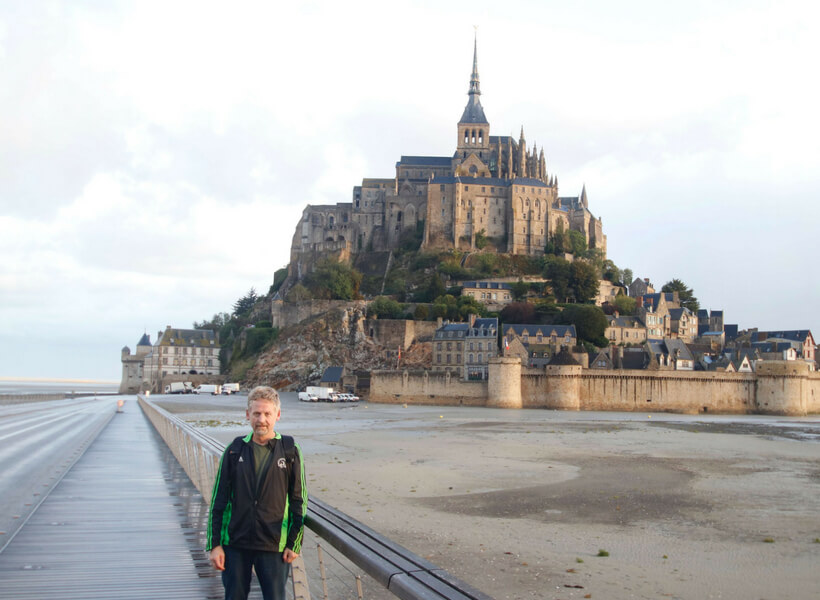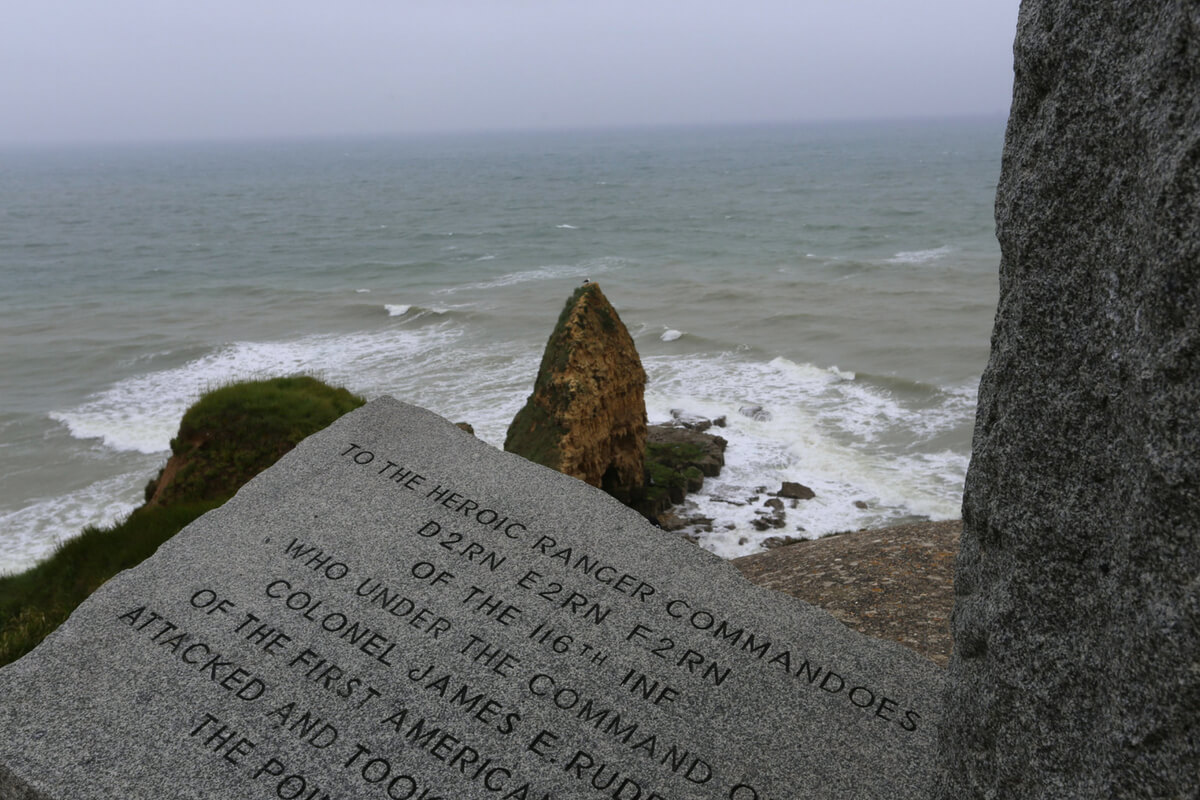Categories: French History, Normandy & Brittany
Discussed in this Episode
- Sainte-Mère Église
- Utah Beach
- Omaha Beach
- Colleville-sur-Mer
- Normandy American Cemetery
- Solo travel in France
About My Guest Phil
Amateur historian, not professional, but with an interest in WWII in general, and particularly the battle of Normandy.
Visited Normandy seven times—five on an anniversary of D-day.
Volunteer at The International Museum of WWII in Natick, MA
Parachuted into Saint-Mère-Église, using period gear and aircraft, with a reenactment group on the past two anniversaries

Preview—D-day versus Battle of Normandy
D-day was June 6, 1944.
Many people equate the Battle of Normandy and D-Day in their minds.
In fact, the Battle of Normandy really describes everything from D-day, on June 6, 1944 up to the liberation of Paris on August 25th of that year. But D-day was the opening salvo in that battle. Largest amphibious attack in history, and likely the largest there will ever be due to the impossibility of hiding such forces these days. Although many people in the U.S. and England refer to it as the “D-day invasion,” the French in the area find that title peculiar. They refer to it not as an invasion, but a “liberation,” as they had already been invaded by Nazi Germany. For the purposes of visiting the WWII sights in Normandy, I’ll refer to the battle in and around the beaches, and inland for the next week or two.
Historical Background
Although America only entered WWII after the bombing of Pearl Harbor by the Japanese Dec. 7, 1941, it really started on September 1, 1939 when Germany invaded Poland. By early 1944, Germany occupied most of Western Europe. The largest three allied countries were The United States, England and Russia. Russia was suffering ferocious battles with the Germans in the East and were desperate for their allies to open up another front in the West. The U.S. and England had battled Hitler’s armies in North Africa and in Southern Italy, but it was accepted that their needed to be a front in France.
France under occupation
France was divided by occupied France in the North, and the collaborationist, Vichy government in the South.
War is expensive, so almost everywhere in the world, everything was rationed—food, tires, petrol, clothing, etc. Occupation was particularly tough as doing without helped your oppressor—plus the oppressor called the shots. In addition, men and buildings, even civilian homes, were requisitioned or taken whenever and wherever they were needed. Normandy did slightly better under rationing than the cities because it was an agricultural area so it produced a lot of food. The Germans would requisition most of it, but it was easier to hide a few pounds of butter where it was made, than in it’s commercial trade into the cities. In general, the Normandy citizens ate better than their Parisian counterparts.
Why Normandy?
England was actually pushing for a front in the South of France. They had had war on their doorstep for years, and were anxious to move it away. However, England was also the staging grounds for much of the men and materials of war, and the logistics of getting those over the ocean and onto mainland Europe were simpler in the North of France where the trip across the English Channel was relatively short. Plus this was slightly closer to the heart of Germany.
The allies needed to not only land and secure the mainland, but the armies war would require continual re-supply. An invading army needs constant reinforcements of men, food, ammunition, trucks and petroleum. All of this necessitates some sort of port.
The most logical place was the Pas-de-Calais. This was the closest point to England, and it was a port that could accommodate large ships. Because of this, the Germans expected an attack here, and the area was heavily fortified. After much analysis, Normandy was chosen because it was relatively close, lager ship could ground there and disembark men and material, and it wasn’t expected by Germany.
Why June 6, 1944?
To make a large-scale, night time, amphibious landing, the allies needed just the right combination of an extremely low tide at dawn, relatively calm seas, clear skies, and a full moon. Originally May 1st was chosen as the date a year in advance. But because the scale of the attack grew to include a fifth landing beach, and the necessity of more landing craft to accommodate this, the attack was postponed to the next favorable weather conditions of June 5, 1944. Although ships were loaded days prior to this and some had even started across the English channel, rough seas and bad weather forecast for the 5th postponed the battle once again. After hearing of a slight break in the weather over the channel, the date of June 6th was chosen.
Planning Stages
Geography of Normandy
Normandy near the English Channel is mostly rural, rolling hills, and small cleared farm fields interspersed with small Norman villages. Most of the villages consisted of a church with a few house clustered around it. A few larger towns or cities like Caen and Bayeux were the transportation and communication hubs. The coast in the area of the landing beaches were long, flat, sandy beaches with extreme variations between the high- and low-tide lines. On Omaha Beach, there were higher bluffs overlooking the beach, with four “draws,” or vehicular exits from the beach area.
German Defenses
Hitler had a daunting task of protecting against a potential attack anywhere along the Western coasts of Europe from Norway to Spain. To do this he constructed his “Atlantik Wall,” to protect his “Fortress Europa” that he claimed was impregnable to attack. He used slave labor, POWs and conscripted French civilians to accomplish this (over 250,000 men, only 10% of which were German). This was a 2,000-mile long system of fortifications, gun emplacements, and obstacles.
The Atlantic Wall consisted approximately 1.2 million tons of steel and 17 million metric meter of concrete. Some of these guns were very large and could reach many miles out to sea. These were typically set well inland and used forward observation posts to direct fire. Others were right on the beach, and all were surrounded by concrete bunkers for men and ammunition, and machine gun turrets protecting them.
Along the flatter beaches, guns were set in a cross-fire pattern so they could sweep the beaches with overlapping fire, and such that their embrasures were not visible from the sea.
At the shore and in the tidal zones were various contraptions designed to make landing extremely hazardous—including mine-tipped poles that were covered during high tide, Belgian Gates, and these cross-shaped iron obstructions.
Inland, especially in the Western sector nearer to Utah Beach, many fields were flooded by careful control of river dams, and large poles were placed in the ground in larger fields to rip up gliders or planes if they tried to land there.
All of this area of Normandy was put under the direction of Field Marshall Edwin Rommel—a brilliant hero of the German army. When Rommel first inspected the fortifications, he found them lacking and implemented a huge escalation of building that was in place, and growing in June of 1944.
Final Plan
SHAEF was headed by General Eisenhower (US)
Head of the ground forces was Bernard Montgomery (UK)
Air Commander-in-Chief Trafford Leigh-Mallory
Naval Commander-in-Chief Bertram Ramsey (US)
Plan included pre-invasion bombardment by over 2,200 bombers, and sabotage being conducted by the French resistance.
Mine-sweeping of paths in the English Channel.
The final plan for “Operation Overlord” Consisted of five landing beaches. These were code-named West to East:
- Utah (American)
- Omaha (American)
- Gold (British)
- Juno (Canadian and British)
- Sword (British)
Attack was to be made at first light, and at low tide.
On each flank of the landing beaches, paratroopers jumped the night before to secure the flanks—the Two American Divisions to the West inland from Utah Beach (82nd and 101st Airborne), and the British 6th Airborne Division to the East inland from Sword Beach. Both were charged with holding the flanks against expected counter-attacks, capturing bridges to keep the German army from getting to the seaborne divisions and disrupting communications behind the lines.
Countries allied in the attack were:
- United Kingdom
- United States
- Canada
- Australia
- Belgium
- Czechoslovakia
- Denmark
- France
- Greece
- Netherlands
- New Zealand
- Norway
- Poland
Utah Beach was added much later on the planning stages, as Eisenhower and his staff felt they needed another bridgehead.
Follow-up waves would land on the beaches, as well as men, vehicles and supplies that were brought in by the glider-borne airborne units.
Supply Requirement Plans
First 20 days required 5,000 tons of gasoline
300 billion units of penicillin
“Invasion”
The bombardment by planes was largely ineffective, and hence Germany’s coastal defenses were mostly intact.
Shortly after midnight on June 5th–6th, British Airborne crash-landed three huge Horsa Gliders at the base of a bridge over the Caen canal and captured it intact.
Around the same time “pathfinder” paratroopers from both the American and British Airborne units landed to set up landing beacons to guide the rest of the airborne troops in. Shortly thereafter, over 20,000 Paratroopers landed with pre-arranged, specific objectives. Because of ground fire, clouds, and lack of pilot combat experience, many of these troopers landed well off target. Some even landed in the ocean and drowned, some landed right in the middle of a German installation and were either shot while still in the air, or captured immediately.
At 6:30am on June 6th, Americans from the 29th? Infantry Division landed on the Western end of Omaha Beach as the first seaborne troops. The actual plan called for minute-by-minute timing of various craft and men to land with very specific tasks. Engineers were in the first waves so they could destroy the beach obstacles and clear paths to the beach that could be followed once the tide came in. There were also amphibious tanks that were supposed to come ashore and support the infantry. But the ones in the American sector were sent in too far out to sea, and in rough waves. 27 out of 32 sunk as soon as they hit the water. The others were quickly disabled on the beach by artillery.
All plans quickly fell apart, and these first troops were slaughtered, and very few remained able to fight. Landing craft were blown out of the water. Fire from the bluffs above Omaha Beach was withering to anyone who made it ashore. Machine guns and artillery raked the beach and couldn’t be hit from the sea. When the few men who could make it up the beach reached the shingle, they had minimal protection from the guns. But very shortly afterwards, the mortars had them zeroed in.
Other beaches had it better and were able to make it inland sooner, but all beaches still weren’t linked up until June 12th.
On “Bloody Omaha” the battle plan was lost. The carefully timed landings and reinforcements fell apart. Landing craft landed in the wrong area, engineers were unable to complete the job of clearing lanes before the tide came in.
The beach quickly became clogged with destroyed vehicles and landing craft, and none of the vehicles could move up the exits.
The fog of war extended out to the higher commanders at sea. They considered cancelling follow-up waves, and devising some sort of plan to evacuate men trapped on Omaha Beach.
Destroyers came in dangerously close to shore to fire directly upon gun emplacements at Omaha Beach.
Gradual small-unit assaults up the bluff finally succeeded in taking Omaha from behind by the end of the day.
British and Canadians moved off the beach and hooked up inland with each other and with their airborne counterparts, but were unable to capture their prime objective of Caen for weeks.
American 101st airborne hooked up with the U.S. 4th Division on one of the causeways leading in from Utah Beach.
American 82nd Airborne captured the crossroads town of Sainte-Mère-Église on D-day, but were under constant attack from German counter-attacks in th North and South. They were unable to capture the La Fiére Causeway until a ferocious battle on June 7–8.
Follow-up Troops and Material
By end of June 11, 326,000 troops had landed.
54,000 vehicles
104,000 tons of supplies
Significant Battles and Sights
Omaha Beach
Normandy American Cemetery
Pointe-du-hoc
Sainte-Mère-Église and the La Fiére Causeway
Utah Beach
Pegasus Bridge
Battle for Caen
Carentan
Saint-Lô
D-day by the numbers
Soldiers, Sailors and Airmen
160,000 (Closer to a Million by the end of June)
American Airborne: Over 13,100 paratroopers (3,937 glider-born follow up troops came in during the day)
British Airborne: 8,500
Ships
Over 6,000 of all kind
Over 1,200 warships
Over 4,100 landing craft
Planes
2,200 bombers
800 Troop-carrying planes
Casualties on D-day (killed, wounded, or MIA):
German: over 10,000 (estimated)
Allied: Over 10,000
U.S.: 6,000 (2,500 on Omaha Beach alone, versus 197 on Utah Beach)
Canadian: over 1,000
Civilian: 3,000 in first two days
By the end of July, 83,000 British, Canadian and Polish casualties, of which almost 16,000 killed.
Fatalities on D-day
Allied: Over 4,414 confirmed
Beyond the Battle of Normandy—Liberation of Paris
Major cities of Caen, Bayeux and Carentan were not captured on the first day. Caen didn’t fall until June 21st.
American armies and armor moved up the Cotentin Peninsula, down the West coast towards Brittany, and the East.
UK and Canadian armies pushed down from Caen creating a pincher move—trapping huge numbers of Germans in the Falaise gap.
After closing the gap, it was a rout chasing the Germans towards Paris.
Subscribe to the Podcast
Apple Google Spotify RSSSupport the Show
Tip Your Guides Extras Patreon Audio ToursRead more about this guest-notes
Episode Page TranscriptCategories: French History, Normandy & Brittany


